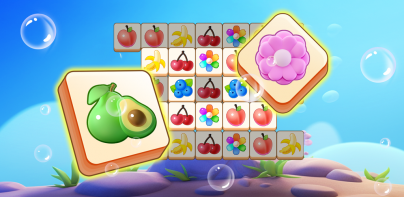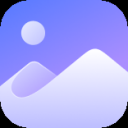



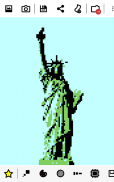
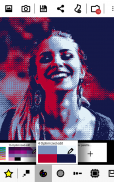
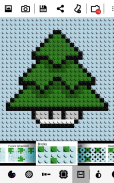

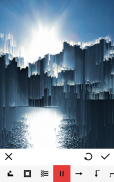
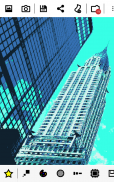
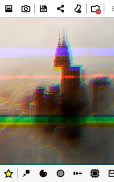
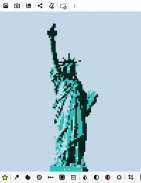

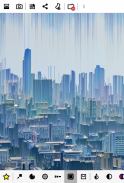
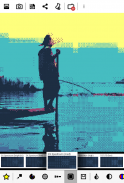
8Bit Photo Lab, Retro Effects

Descrição do 8Bit Photo Lab, Retro Effects
8Bit Photo Lab converts any picture on your phone or straight from your camera to retro 8-bit pixel art!
Choose a picture, scroll through a selection of pre-defined 8-bit filters and immediately review the vintage effect. Save or share the result in just one click!
Features
★ make pixel art, pixelate your photos, create memes, design flashy posters, have fun!
★ choose from over 50 color palettes: GameBoy, GameBoy Advance, NES, TO7/70, Amstrad CPC 6128, Apple II, ZX Spectrum, Commodore 16 & 64, VIC 20, CGA, EGA, Atari ST, Amiga, VGA (256 colors)...
★ custom color palettes with the option to interpolate colors, allowing for duotone effects
★ 15 dithering types: error diffusion, noise, pattern, checkerboard...
★ huge finely selectable resolution range from 8 x 8 to 2048 x 2048
★ multiple pixel aspect ratios and attribute clash modes
★ output styles offer alternatives to regular flat pixels: fuse beads, bricks, puzzle, painted...
★ add retro 8-bit text and glitches
★ tastefully decorate with a selection of 8-bit stickers
★ flick right or left and immediately apply the filter to another picture from your collection!
★ high quality output, up to 4096 x 4096 in PNG
★ optional grid overlay for bead artists and cross-stitchers
The app has two goals: be dead simple to use and powerful enough to produce good-looking and effective results.
The reality of old school graphic conversions is that it can be tricky to get good results in all conditions. Low contrast or greyish images tend to be rendered as a murky mess if a straightforward downsampling is applied. 8Bit Photo Lab has a number of parameters that are key to optimizing the final look of your images. Every pixel counts when dealing with low resolution images.
Usage
Start off with one of the predefined looks (star icon) then mix and match colors, ditherings, resolutions and more until you get the effect you want.
Change a parameter and the result is immediately updated. Browse through multiple looks in an instant!
The three main parameters are resolution, palettes and dithering. Ditherings allow to simulate a larger range of colors than what the limited palette offers. Various options are offered here. Pattern dithering was often seen used in older paint software as well as the user interfaces for many operating systems. Checkerboard dithering was commonly employed in games. Error diffusion, gives the most faithful rendering.
Four parameters adjust color values for each pixel. You'll find familiar brightness, saturation and contrast settings as well as the very useful local contrast setting (also known as unsharp mask). Local contrast is very effective at bringing out detail and allowing to reduce resolution while retaining good subject definition. As an interesting side effect, reducing local contrast produces a soft focus effect which may take your art in another direction altogether. Giving saturation a boost can help make the most of some of the flashy color palettes.
Cropping will allow you to select just the part of your pic that you like. A tiny part of an image can still have enough resolution to be turned to an 8-bit picture. Even if your subject is small there is hope!
Old computers had few colors to play. They also crashed often in weird ways. Use the glitch menu (blender icon) to add mayhem to your pics. Screen melt, pixel scattering, pixel sorting, cellular automaton, block swapping, RGB offsetting, interlacing are on the menu.
Finally a good old text tool is always useful, whether you're looking to make memes, add a title or a text bubble, the app has a large selection of 8-bit fonts and borders to choose from!
PRO version
Unlocks the following:
★ wallpapers
★ larger range of parameters
★ more ditherings and palettes, including custom palettes
★ extra fonts and borders
★ extra glitches
★ lossless file compression (PNG), higher output resolution (up to 4096 x 4096), 1:1 output resolution
8Bit Photo Lab converte qualquer foto no seu telefone ou diretamente de sua câmera para retro pixel art 8-bit!
Escolha uma imagem, percorrer uma seleção de filtros de 8 bits pré-definidos e rever imediatamente o efeito do vintage. Salvar ou compartilhar o resultado em apenas um clique!
Características
★ fazer arte pixel, pixelate suas fotos, criar memes, projetar cartazes chamativos, divirta-se!
★ escolher entre mais de 50 paletas de cores: GameBoy, de Game Boy Advance, NES, a 7/70, Amstrad CPC 6128, a Apple II, ZX Spectrum, Commodore 16 e 64, VIC 20, CGA, EGA, Atari ST, Amiga, VGA (256 cores ) ...
★ paletas de cores personalizadas com a opção para interpolar cores, permitindo efeitos duotônicas
★ 15 tipos Composição de cores: difusão de erro, ruído, padrão, xadrez ...
★ enorme gama resolução finamente selecionável de 8 x 8 até 2048 x 2048
★ várias proporções de pixel e modos atributo clash
★ estilos de saída oferecem alternativas para pixels planas regulares: contas de fusíveis, tijolos, quebra-cabeça, pintado ...
★ adicionar texto de 8 bits retro e falhas
★ decorar com bom gosto com uma seleção de 8 bits adesivos
★ filme de direita ou esquerda e imediatamente aplicar o filtro para outra imagem de sua coleção!
★ produção de alta qualidade, até 4096 x 4096 em PNG
★ sobreposição de grade opcional para artistas talão e cross-stitchers
O aplicativo tem dois objetivos: ser muito simples de usar e poderoso o suficiente para produzir boa aparência e eficazes resultados.
A realidade de conversões gráficos da velha escola é que ele pode ser difícil de obter bons resultados em todas as condições. Baixo contraste ou imagens acinzentadas tendem a ser processado como uma bagunça escura se um downsampling direta é aplicada. 8bit Photo Lab tem uma série de parâmetros que são fundamentais para otimizar a aparência final de suas imagens. A cada pixel conta quando se lida com imagens de baixa resolução.
Uso
Comece com um dos olhares predefinidos (ícone de estrela), em seguida, misturar e combinar cores, ditherings, resoluções e mais até obter o efeito desejado.
Mudar um parâmetro e o resultado é imediatamente actualizado. Navegar através de múltiplos olhares em um instante!
Os três parâmetros principais são a resolução, paletas e indecisão. Ditherings permitem simular uma gama maior de cores do que o que a paleta limitada oferece. Várias opções são oferecidas aqui. Padrão hesitar foi visto frequentemente usado em software de pintura mais velhos, bem como as interfaces de usuário para muitos sistemas operacionais. Checkerboard indecisão era comumente empregado em jogos. difusão de erro, dá a tradução mais fiel.
Quatro parâmetros ajustar os valores de cor para cada pixel. Você vai encontrar familiares configurações de brilho, saturação e contraste, bem como a definição de contraste local muito útil (também conhecido como máscara de nitidez). contraste local é muito eficaz em trazer para fora detalhes e permitindo reduzir resolução, mantendo boa definição assunto. Como um efeito colateral interessante, reduzindo o contraste local produz um efeito de foco suave que pode levar a sua arte em outra direção completamente. Dando saturação de um impulso pode ajudar a tirar o máximo partido de algumas das paletas de cores chamativas.
Recorte permite-lhe seleccionar apenas a parte do seu pic que você gosta. Uma pequena parte de uma imagem ainda pode ter resolução suficiente para ser transformado em uma imagem de 8 bits. Mesmo se o assunto é pequeno, há esperança!
Computadores velhos tinham poucas cores para jogar. Eles também caiu muitas vezes em formas estranhas. Utilize o menu de falha (ícone liquidificador) para adicionar o caos para suas fotos. melt tela, espalhamento de pixel, classificação pixel, autômato celular, bloco de troca, RGB compensação, entrelaçamento estão no menu.
Finalmente uma boa ferramenta de texto antigo é sempre útil, se você está procurando para fazer memes, adicionar um título ou uma bolha de texto, o aplicativo tem uma grande selecção de fontes de 8 bits e fronteiras para escolher!
versão PRO
Desbloqueia o seguinte:
★ wallpapers
★ maior gama de parâmetros
★ mais ditherings e paletas, incluindo paletas personalizadas
★ fontes extras e fronteiras
★ falhas extras
★ compressão de arquivos sem perdas (PNG), maior resolução de saída (até 4096 x 4096), 1: resolução 1 saída







